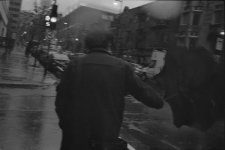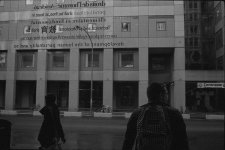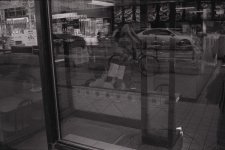Lauffray
Invisible Cities
I'd like to draw on your experiences here, do you think these negs (straight from scanner) are underexposed or underdevelopped ? how can you tell ?
All shot on AE on my M7 and developped in D76 using times from the massive dev chart.
I've never had exposure trouble with the M7 since I bought it but these last rolls were disapointing, muddy tones, fuzzy details, dark and no contrast.
Also, how long should I fix pushed films ?
(TriX@1600 , D76 stock for 9.5min, fixed with ilford fixer for 5min)
Thanks
All shot on AE on my M7 and developped in D76 using times from the massive dev chart.
I've never had exposure trouble with the M7 since I bought it but these last rolls were disapointing, muddy tones, fuzzy details, dark and no contrast.
Also, how long should I fix pushed films ?
(TriX@1600 , D76 stock for 9.5min, fixed with ilford fixer for 5min)
Thanks
Attachments
Last edited:
dfoo
Well-known
I don't think you can tell from scans. How do the negatives look? Are the shadows well exposed? For example, in the center image is the texture in the guys jacket? For underdevelopment I'd look to see how dense the densest part of the negative is. If you are lacking density, I'd say you have underdeveloped the negs.
Stuart John
Well-known
Well if the film was TriX at EI 1600 then no doubt under exposed. You under exposed the film when you rated it at EI 1600. The shadow detail that was not captured will not likely be brought back by push processing.
From the scans though it is hard to tell you need to look at the negs themselves to judge the shadow detail and highlight density. You don't have to accept scans straight from the scanner you can adjust the scans in PS or some other imageing software rather like you would adjust print exposure and contrast when working in a darkroom.
From the scans though it is hard to tell you need to look at the negs themselves to judge the shadow detail and highlight density. You don't have to accept scans straight from the scanner you can adjust the scans in PS or some other imageing software rather like you would adjust print exposure and contrast when working in a darkroom.
Lauffray
Invisible Cities
For reference I'm comparing against the roll of Neopan 1600 developped in D76 the week before those, that one gave me some pretty nice tones and good contrast without PS.
I know I can always fix them in PS, but I thought pushing film was supposed to boost contrast ??
I know I can always fix them in PS, but I thought pushing film was supposed to boost contrast ??
dfoo
Well-known
Neopan is a faster film. If you want more contrast, develop the film for longer. However, you cannot bring out details that are not on the film (ie: expect empty shadows).
Roger Hicks
Veteran
Scans really tell you nothing.
Look at the negs.
No real detail in the darkest areas = underexposed.
Detail, but hopelessly weak and hard to see = either underexposed or underdeveloped.
The only easy way to tell 'underdeveloped' is to try wet printing. If you need mostly grades 4 and 5, they're underdeveloped. Mostly grades 0 and 1, they're overdeveloped. Scanning can compensate easier and better for more than wet printing can.
But there's not much point in using anything other than chromogenic mono for scanning anyway, ideally XP2 Super. Chromogenics wipe out the Callier effect, which leads to excessive contrast, and grain aliasing.
Cheers,
R.
Look at the negs.
No real detail in the darkest areas = underexposed.
Detail, but hopelessly weak and hard to see = either underexposed or underdeveloped.
The only easy way to tell 'underdeveloped' is to try wet printing. If you need mostly grades 4 and 5, they're underdeveloped. Mostly grades 0 and 1, they're overdeveloped. Scanning can compensate easier and better for more than wet printing can.
But there's not much point in using anything other than chromogenic mono for scanning anyway, ideally XP2 Super. Chromogenics wipe out the Callier effect, which leads to excessive contrast, and grain aliasing.
Cheers,
R.
ederek
Well-known
I'm pretty sure Trix and Neopan have different base+fog densities as well, so if you used the same scanner settings for max/min point, you'd see a difference. How do the scans compare in the area between frames?
Clovis
Established
If roll is underdeveloped the exposed leader and edge markings will be lighter or missing compared to a properly developed roll.
Scans always need to be processed to increase contrast, as the scanner usually gives you flat negatives to maximize dynamic range information.
Scans always need to be processed to increase contrast, as the scanner usually gives you flat negatives to maximize dynamic range information.
Fawley
Well-known
You cannot expect to develop shadow detail when pushing Trix to 1600. I think what's concerning you is a lack of contrast. The scans have no punch. If the negs also show a lack of contrast, then you haven't developed enough
nikon_sam
Shooter of Film...
Try testing another roll on a sunny day...as you can see it's raining in these shots and the sun is hiding behind some clouds...soooo it's gonna be a little grayish to begin with...
Look for something that has black and white in it (a sign or something) then bracket a few shots making good notes of what's what...try developing it again and adjust accordingly...
Look for something that has black and white in it (a sign or something) then bracket a few shots making good notes of what's what...try developing it again and adjust accordingly...
sniki
Well-known
What about the frames numbering on developeded film; how do they appear: weak, normal or bold?
Lauffray
Invisible Cities
The frame numbers look normal, the area between the frames also look normal. On the negs, there is some detail in the shadow, a bit less than usual, but visible.
Thanks a lot everyone !
Thanks a lot everyone !
Share:
-
This site uses cookies to help personalise content, tailor your experience and to keep you logged in if you register.
By continuing to use this site, you are consenting to our use of cookies.



